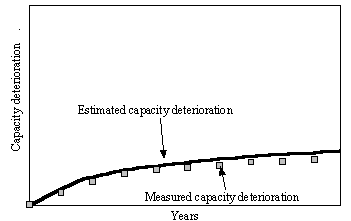| Verifications of the Battery Adaptation in the Market and Estimation of Battery Life for EV, HEV (2) |
|
2.2 Estimation of battery deterioration
With the proposed method of estimating battery deterioration, the rate of deterioration is found for every factor related to battery deterioration under
the conditions of vehicle use. The individual rates are then summed to find the total rate of battery deterioration.
2.2.1 Method of estimating battery deterioration
The procedure used in estimating battery deterioration is outlined in Fig.10. Cycling durability tests and storage durability tests are performed on the battery
cells under different temperature conditions to obtain the correlation between the number of cycles and battery deterioration and that between the number of days
in storage and battery deterioration. The next step is to find the correlation between deterioration and battery temperature and that between deterioration and DOD.
In addition, vehicle-driving loads are replaced by battery load conditions; the number of cycles and the number of days in storage are determined for each set of driving
conditions. The cycling deterioration rate and the storage deterioration rate are then determined from the correlation with cycling deterioration and the correlation with
storage deterioration that were found for each set of conditions. The battery deterioration rate is then calculated on the basis of those results.
 Figure10: Outline of method for estimating battery deterioration
Figure10: Outline of method for estimating battery deterioration
2.2.2 Actual driving pattern models and battery load conditions
Actual driving pattern models were created for both the Altra EV and the Tino HEV in order to estimate battery deterioration under conditions of real-world use. Table 2 shows an example of an actual driving pattern model created for the Altra EV. This model assumes three patterns of use by ordinary users. Driving distance, charging time, discharging time and number of charges were defined for each pattern of daily use assumed for the Altra EV. Similarly, driving distances and discharge times were defined for the Tino HEV. Ambient temperatures were also set for each season.

Table2: Actual driving pattern model for EV
In the example shown in Table 3, battery load conditions have been substituted for the actual driving pattern model in Table 2. The conditions pertaining to the battery load, such as the number of charges and discharges, the number of days stored under a no-load condition and others, are grouped according to each battery temperature. The data for each set of conditions are added up and used in estimating battery deterioration in real-world use.

Table3: Battery load conditions for EV batteries
2.2.3 Validation of EV battery deterioration estimates--bench durability tests
Using the proposed method of estimating battery deterioration, estimates of capacity deterioration were calculated based on the actual driving pattern models. The calculated results are compared in Fig.11 with actual battery deterioration data measured in bench durability tests that simulated the assumed driving patterns. Good agreement is seen between the estimated and measured capacity deterioration data. This verified that the method of estimating battery deterioration is capable of producing sufficiently accurate estimates of capacity deterioration.

Figure11: Comparison of capacity deterioration estimated from EV actual driving patterns and measured capacity deterioration
Reference
Fumihiko Saito, Norihiko Hirata, Shinya Ogata, Kenichi Sakai and Takeshi Miyamoto
Verifications of the Battery Adaptation in the Market and Estimation of Battery Life for EV, HEV
The 18th International Electric, Fuel cell and Hybrid vehicle Symposium October 20-24, 2001 Berlin, Germany
|
|